1lumen selects and reviews products personally. We may earn affiliate commissions through our links, which help support our testing.
Sofirn SP60 review
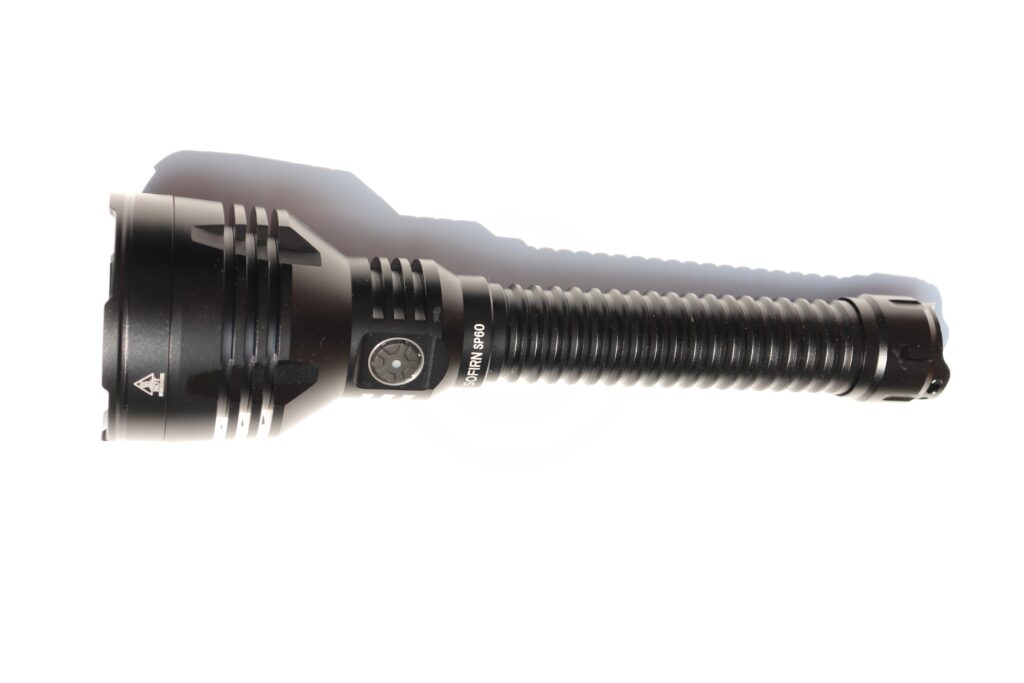
Sofirn SP60 specs
| Brand & Model | Sofirn SP60 |
|---|---|
| Flashlight category | Camping, hiking, fishing |
| LED | XHP70.3 HI (4700-5300K) |
| Max. output | 6800 lumens |
| Max. beam distance | 915 meters |
| Max. beam intensity | 209500 cd |
| Battery config. | 2* 21700 |
| Onboard charging | Yes |
| Modes | 6 |
| Blinkies | Yes |
| Waterproof | IP68 |
| Review publication date | July 2023 |
Review intro:
As a rule I find I’m more drawn to smaller pocket sized flashlights, however the SP60 from Sofirn looks to have an appeal all of its own, offering 2 x 21700 battery configuration, a domeless LED and a large reflector.
All of this with the packaging convenience of an electronic slide switch and on-board USB charging.
Package quality.
The SP60 comes packed in a sturdy unbranded brown box, but well secured inside with foam.
You get some things included:
- 2 x Sofirn 5000mAh 21700 batteries
- Battery adapter tube
- 2 x spare o-rings
- Lanyard
The lanyard is a little weird, it is much longer than the wrist style ones you normally get, which makes sense given the length of the SP60. But the lanyard doesn’t seem to be thin enough to attach to the light anywhere…
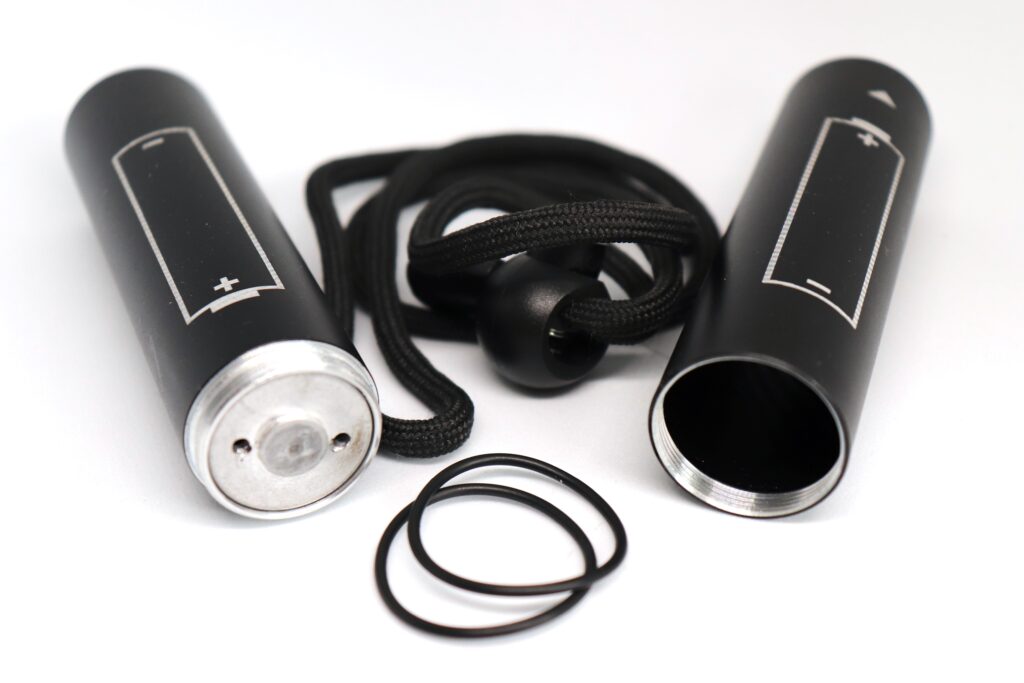
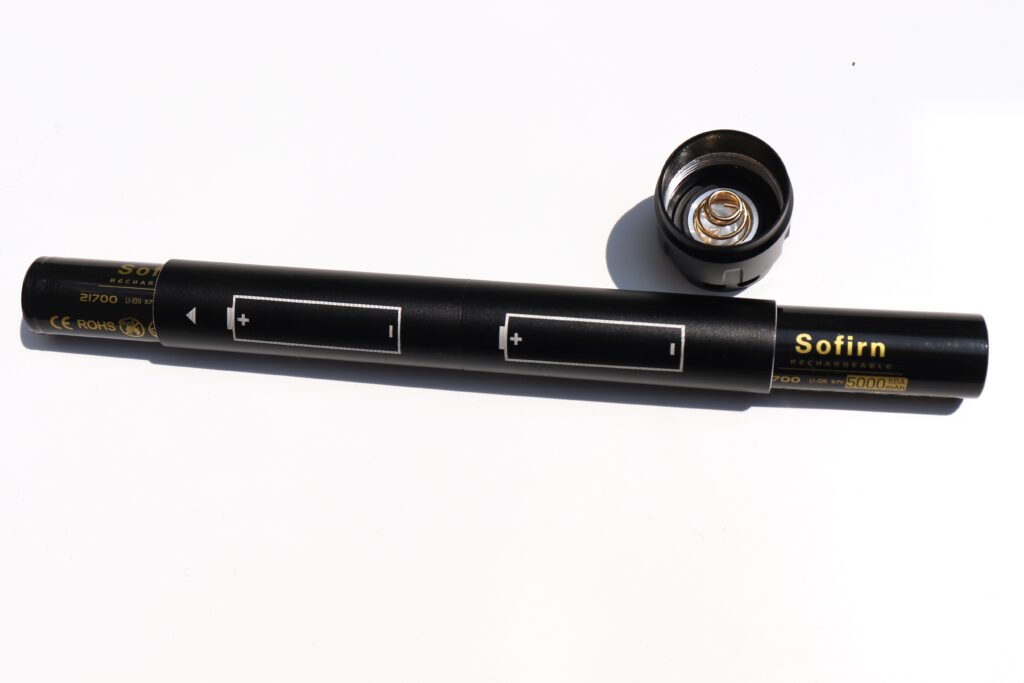
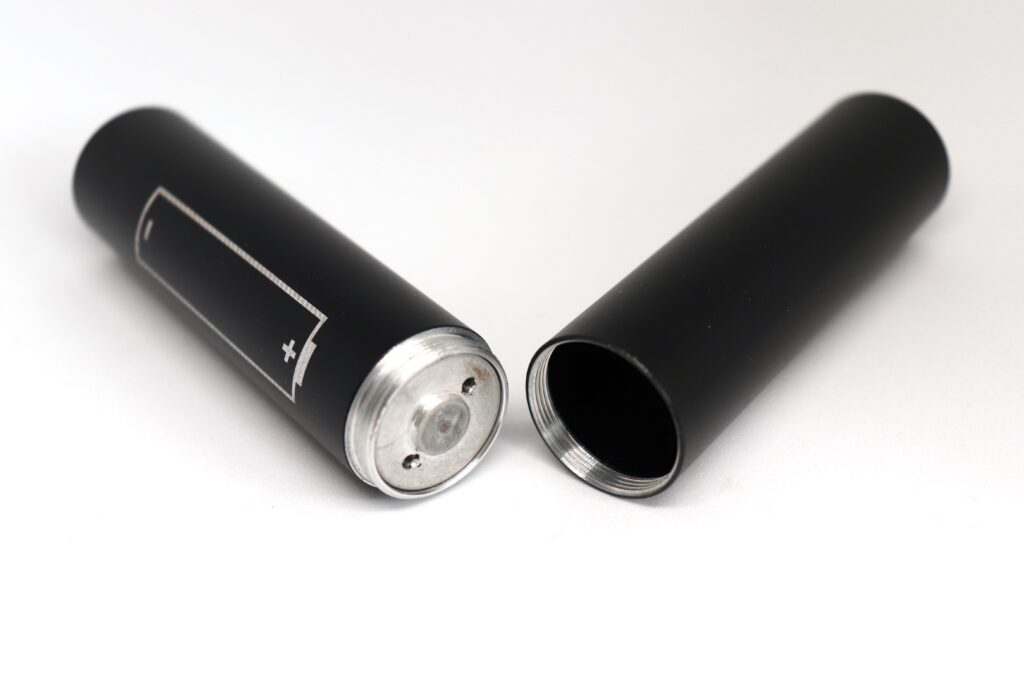
Flashlight in use
The SP60 has a chunky good feel in the hand flashlight. It is on the heavy side, despite being similar in size to the 3D cell Maglite, but with a narrower body and larger reflector, it does have some heft to it. This is not a casual use carry light and for younger users probably too heavy.
Sofirn claims it would be good for hiking, camping, fishing, indoor- and outdoor activities. I’m not so sure on the indoor use, it does have a moonlight and low modes, but is too unstable to tail stand safely and too large to be of much use in anything smaller than a warehouse.
The UI is very much a general-use kind of UI and has no tactical elements to it at all. Ruling the SP60 out as any kind of tactical or security use.
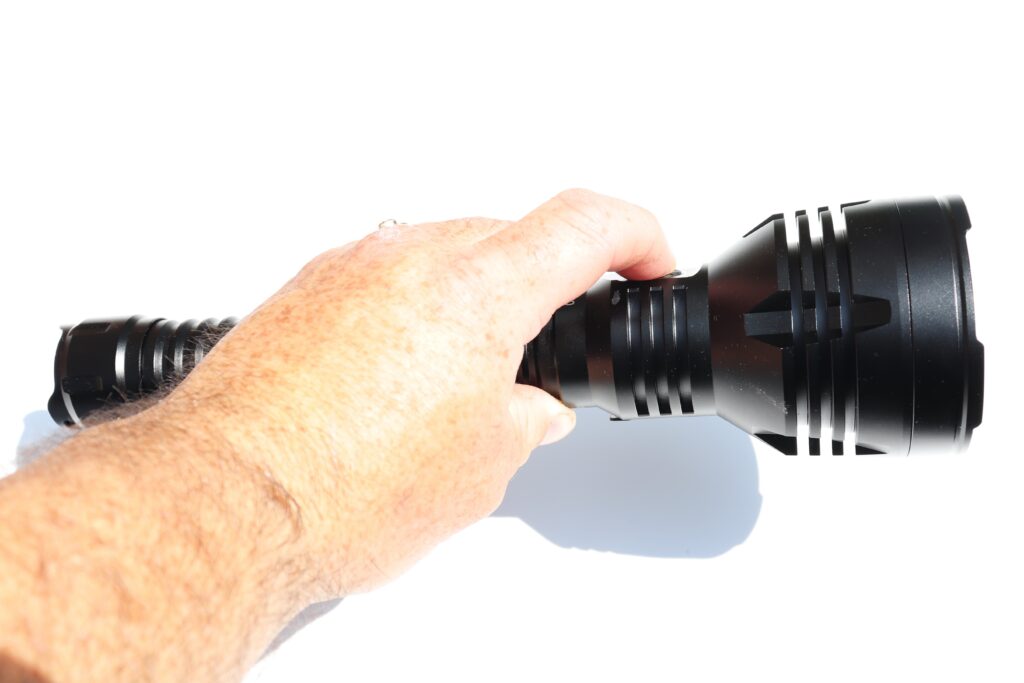
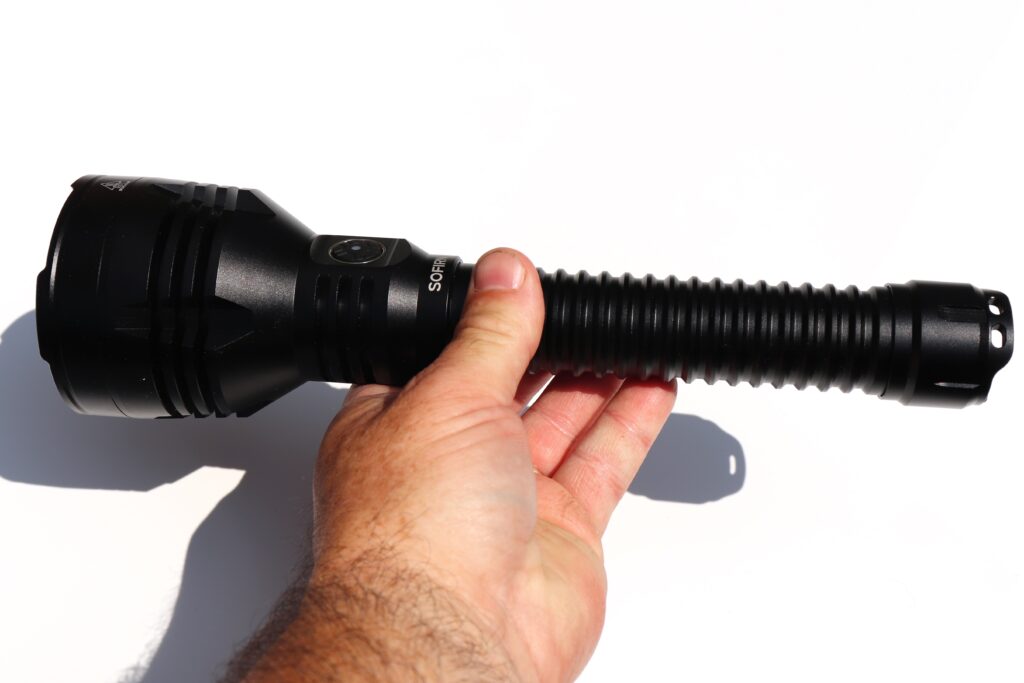
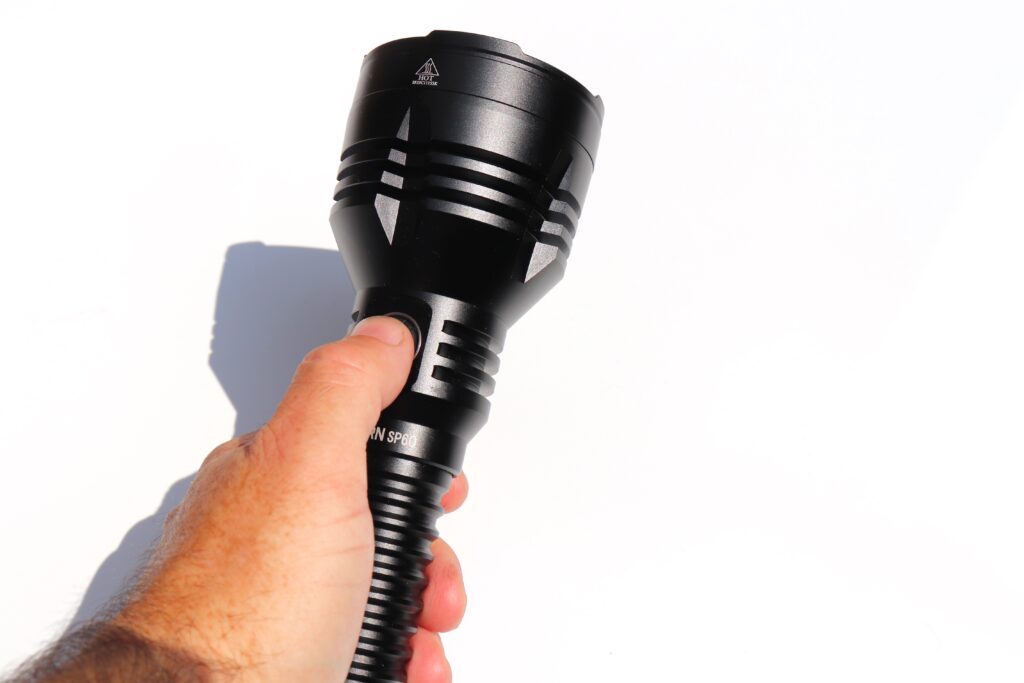
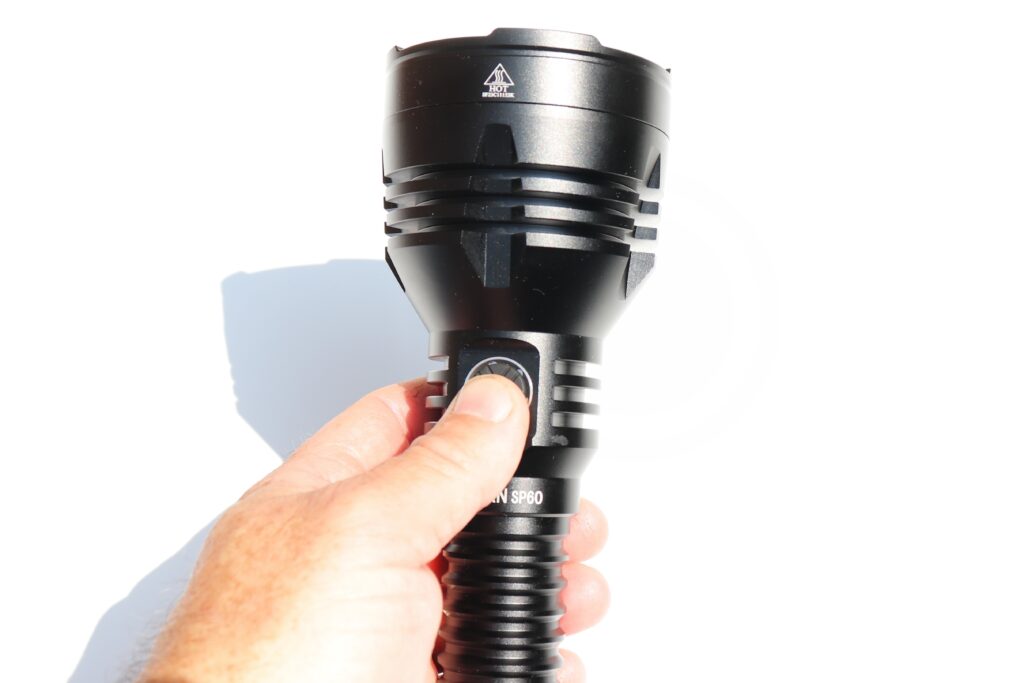
Build Quality and Warranty
Heavy duty build quality is the first thing that comes to mind when looking at the SP60. All of the aluminium is thick and heavy and very well machined. Every part of the light seems to be well put together, although it doesn’t look to be a flashlight for the modding community and it doesn’t disassemble very far.
The strangest design choice I can see from a build quality point of view are the threads on the end of the body for the tailcap. Normally you’d expect these to be anodised to allow for a physical lockout, but they aren’t. And look to have been machined post anodising, which gives a bit of a wonky line where the threads start.
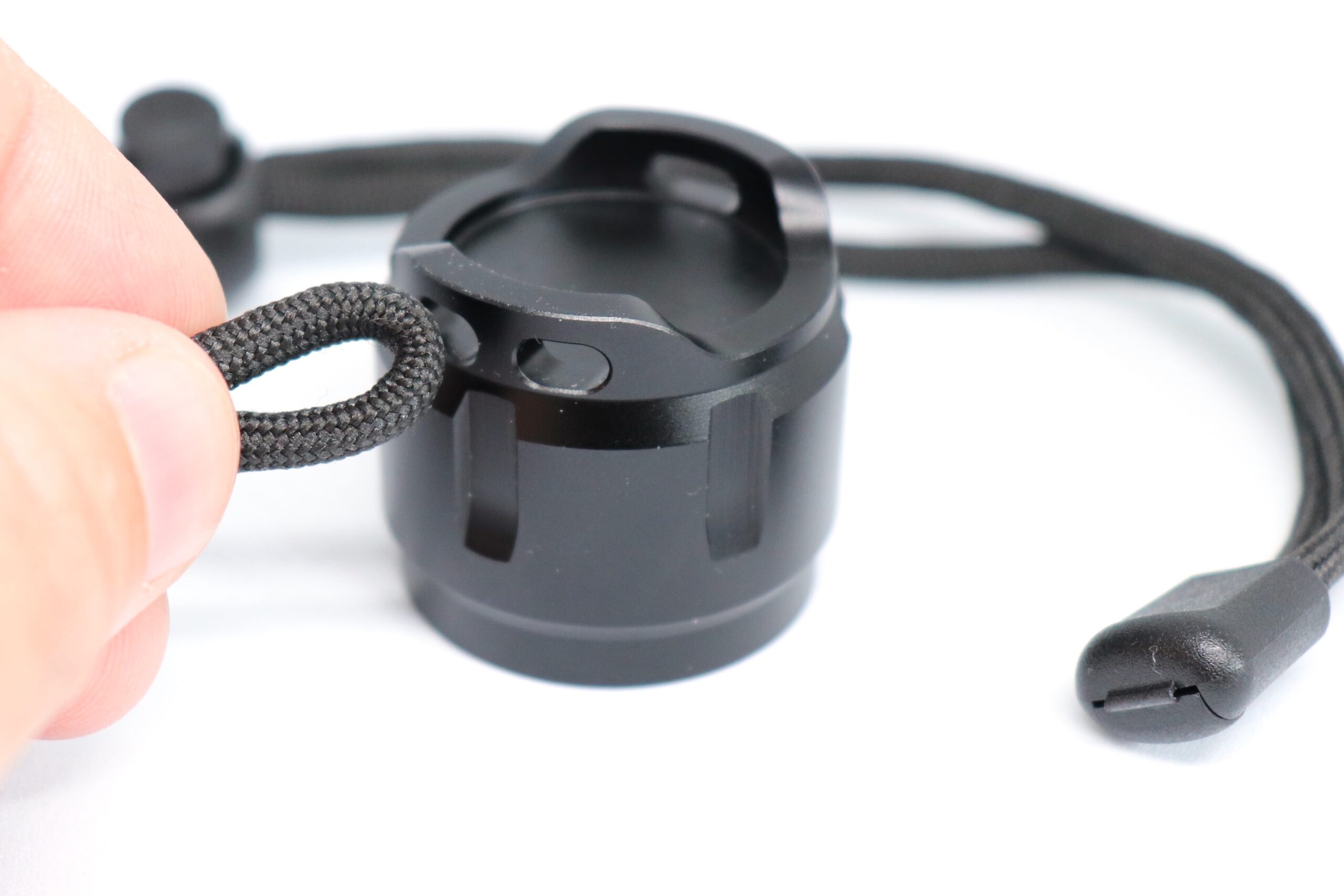
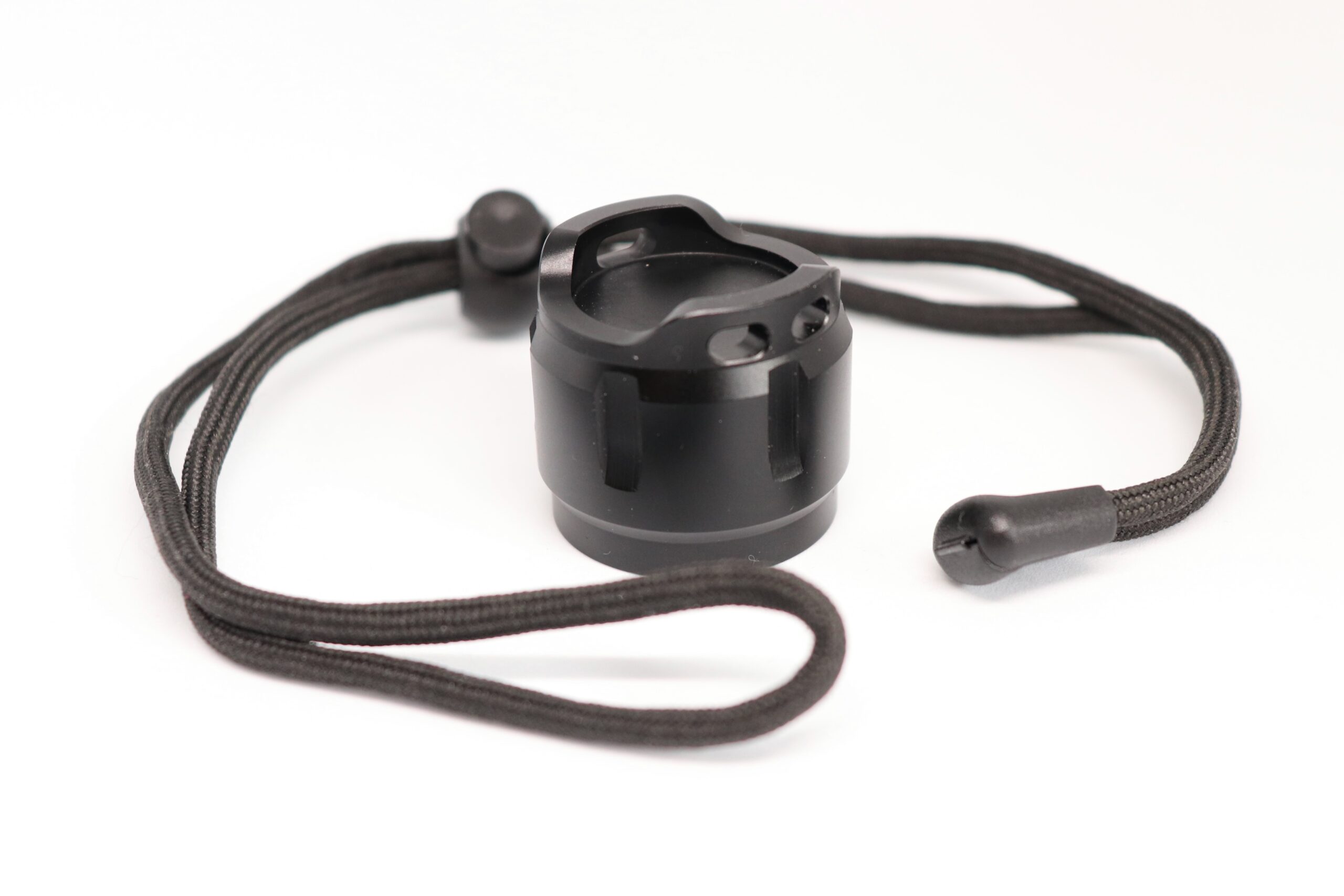
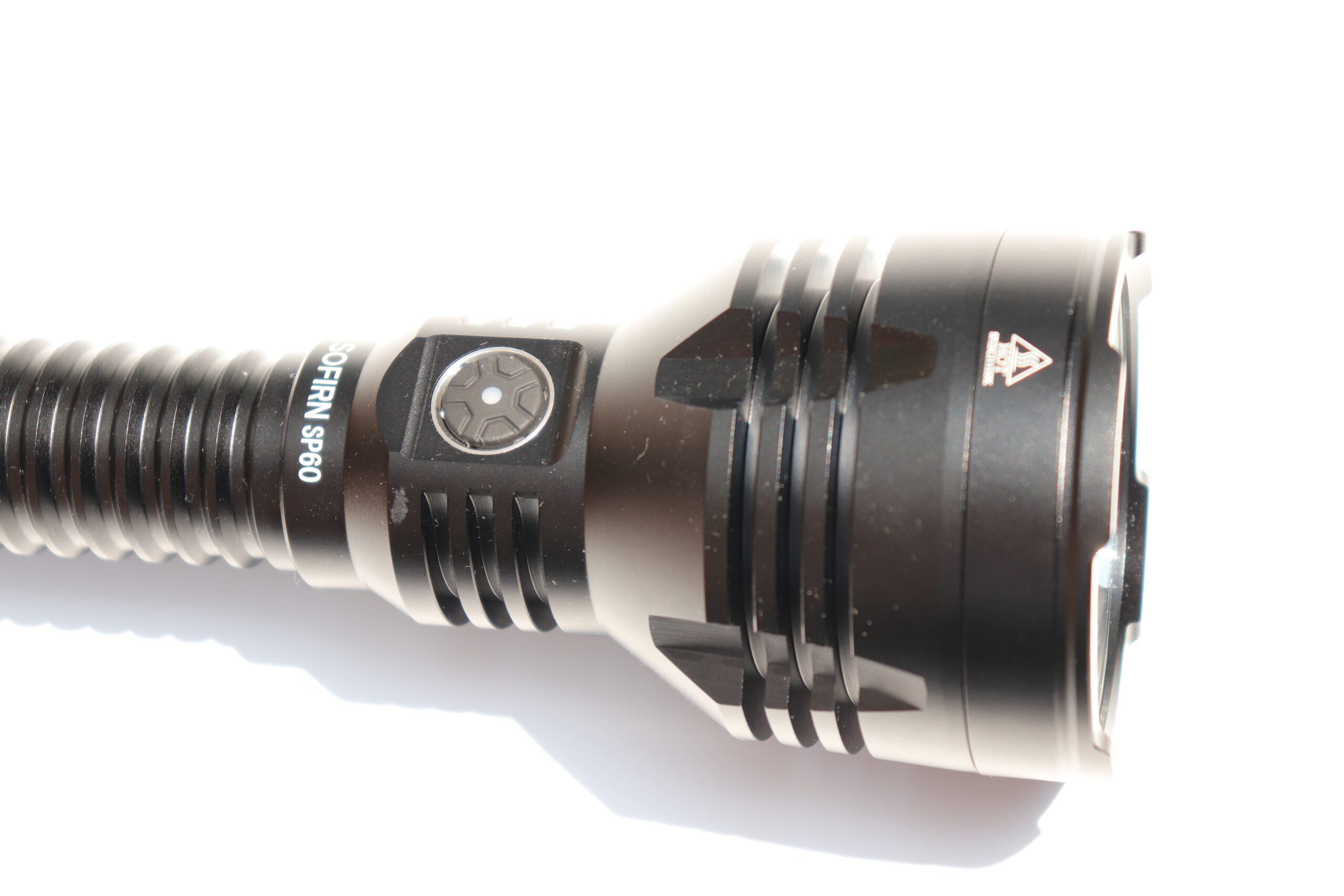
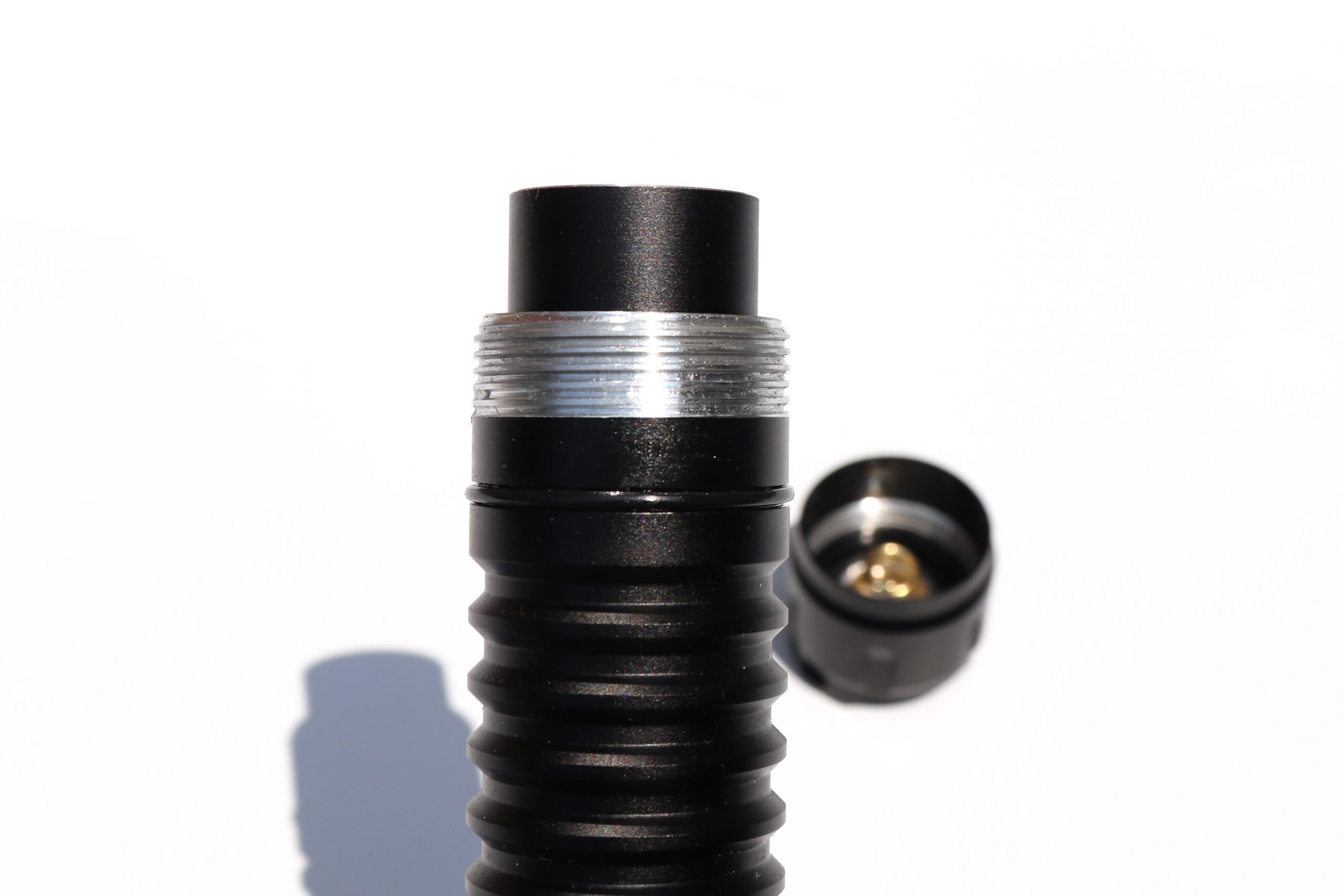
LED, Lens, Bezel, Beam, and Reflector
At the business end of the SP60 we find a XHP70.3 HI LED sitting in a large Orange Peel (OP) reflector.
The XHP70.3 HI is a domeless LED with four dyes although as it has been coupled with an OP reflector I’m guessing that ultimate throw was not the main aim.
And to be perfectly honest the beam is really good, it has a nice well-defined hotspot and bright spill beam. The hot spot is large too. In fact my only slight niggle with the beam is that it is perhaps a little on the cool side for my liking, but it really only a minor gripe.
Performance wise the SP60 packs a wallop, lots of lumens, and is very bright with very good throw. I like how the beam isn’t pencil thin, so out across the fields it lights up a decent sized area with ease.
On lower modes the beam is just as good too. And I like how a nice low Moonlight output has been included, allowing you to use it in all situations from a beam and output point of view. Being large and heavy however, means there will be occasions when a physically smaller may well be a preference.
Opple Light Meter results tested in High mode:
- 5577 CCT (K)
- CRI 70.6 Ra
- x= 0.3307
- y = 0.3366
- u = 0.2074
- v = 0.3166
There is a nice glass lens covering the large reflector with a mildly crenulated aluminium bezel, this will be handy to identify if you have left the light switched on by mistake.
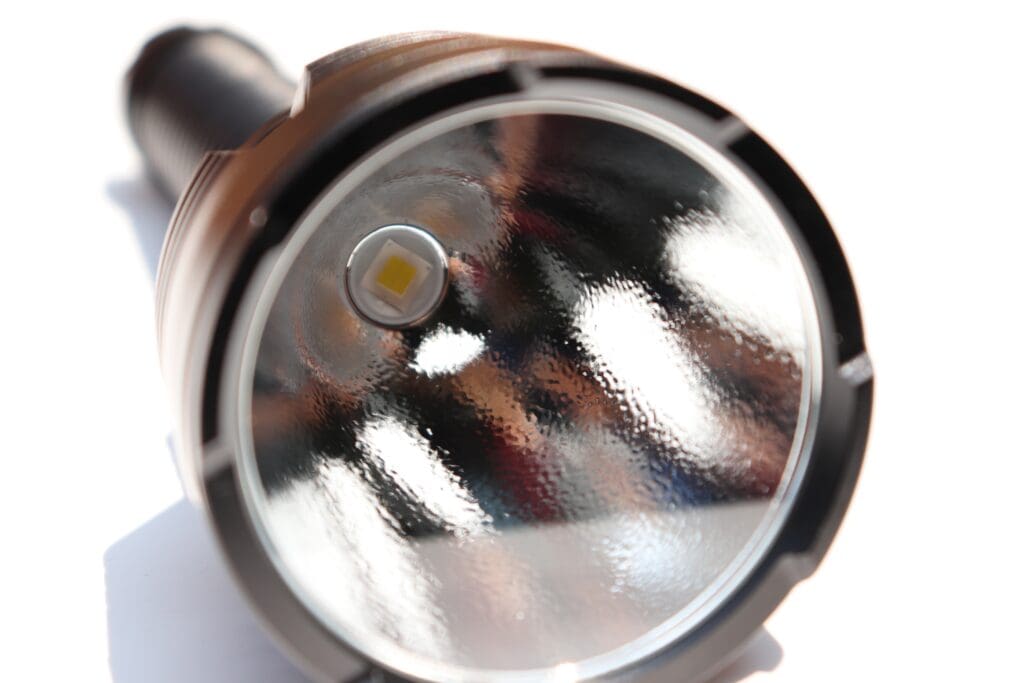
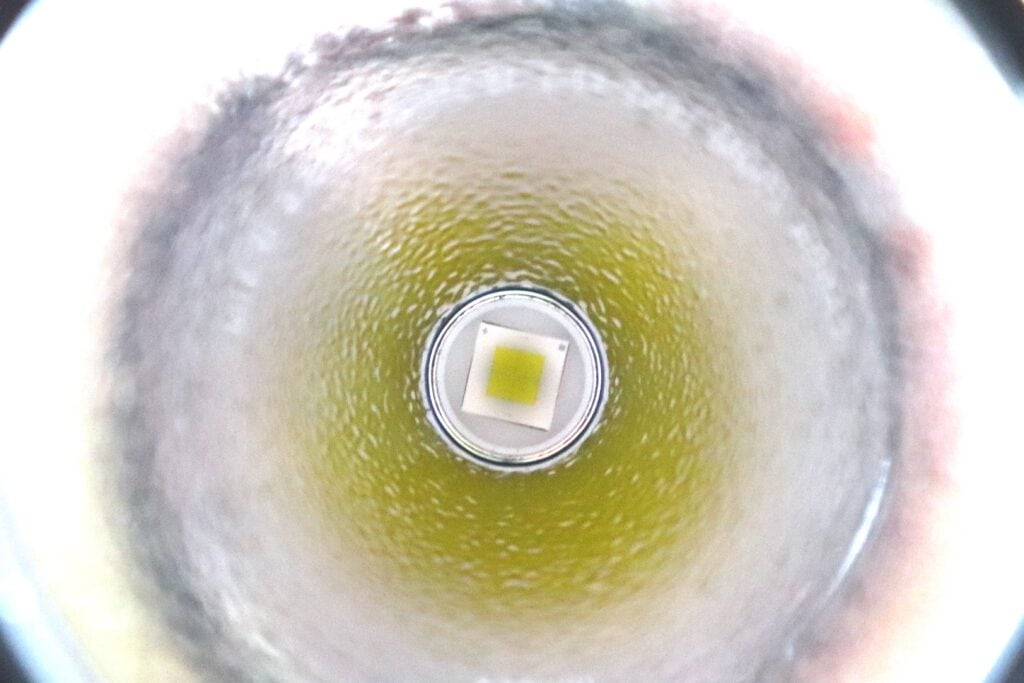
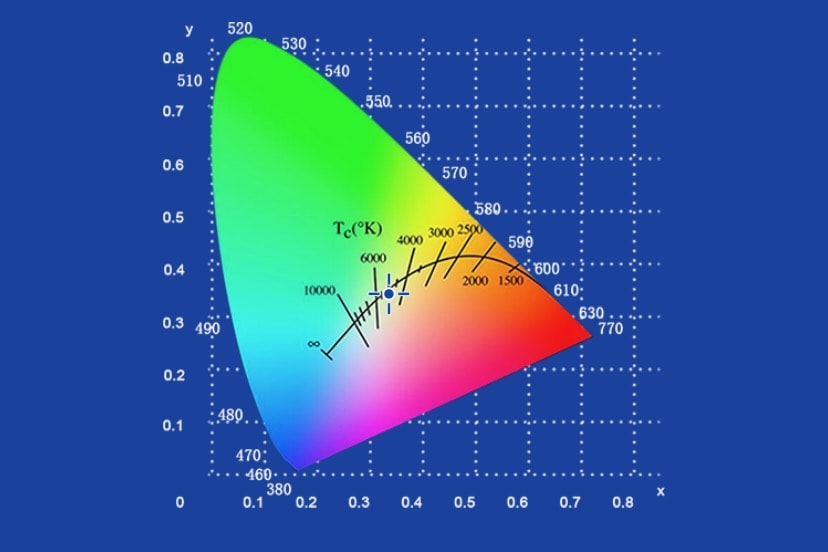
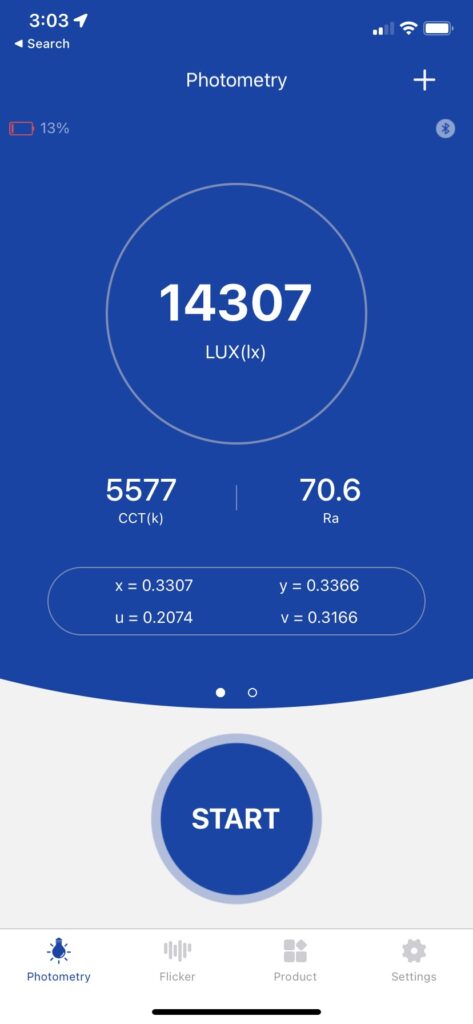
Dimensions and its competition
Dimensions:
| Millimetres | Inches | |
|---|---|---|
| Length | 258.5 mm | 10.18 |
| Head diameter | 70 mm | 2.76 |
| Body diameter | 31 mm | 1.22 |
Dimensions are rounded to the nearest millimeter, and to the nearest tenth of an Inch.
Weight:
| Weight in grams | Weight in Oz | |
|---|---|---|
| Without battery: | 418g | 14.75oz |
| With battery | 550g | 19.40oz |
Weight is rounded to the nearest gram, and to the nearest tenth of an Oz.
Flashlight size comparison with its competition:
Big to small: Sofirn SP60, Maglite 3C, Astrolux FT03, Astrolux EA01
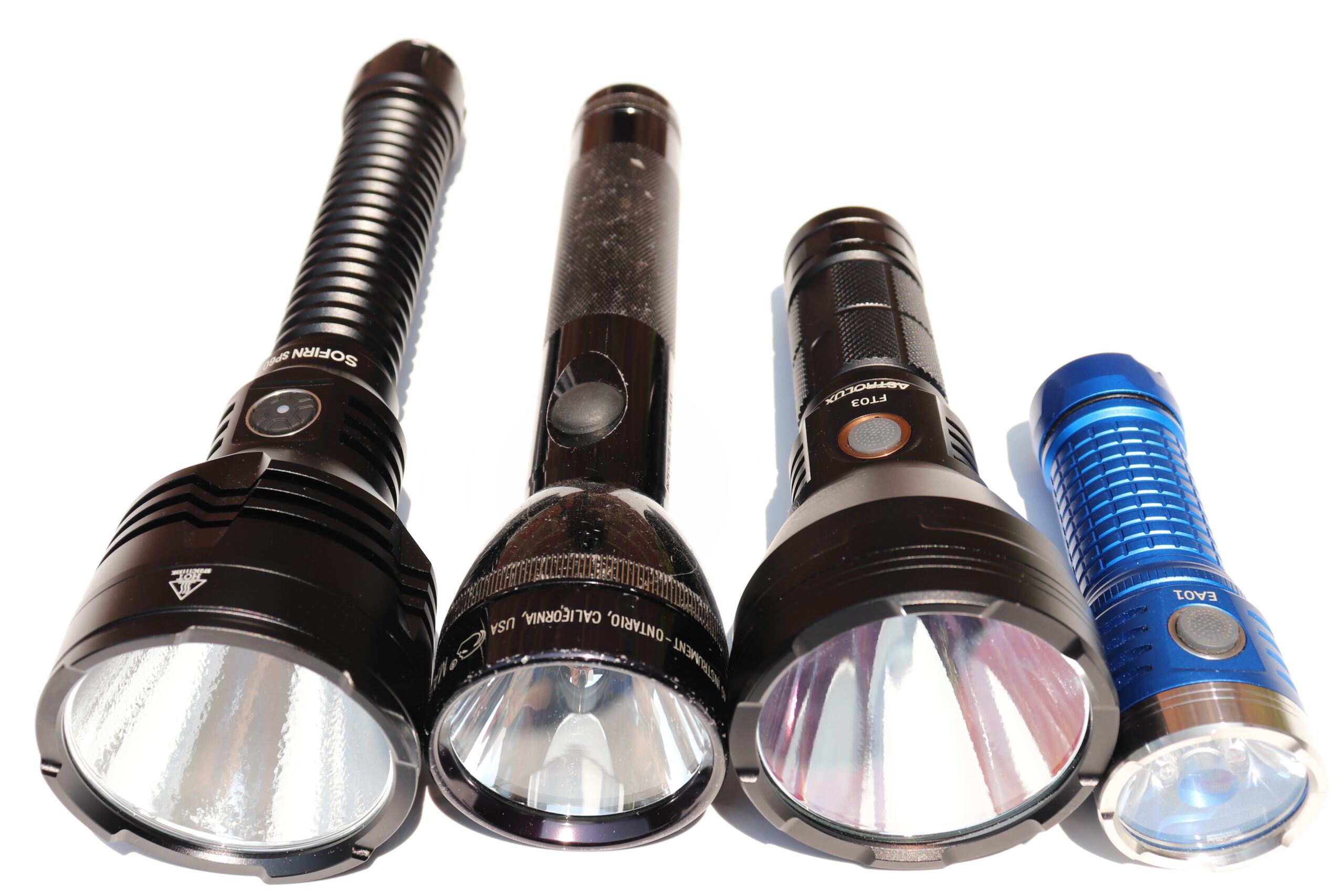
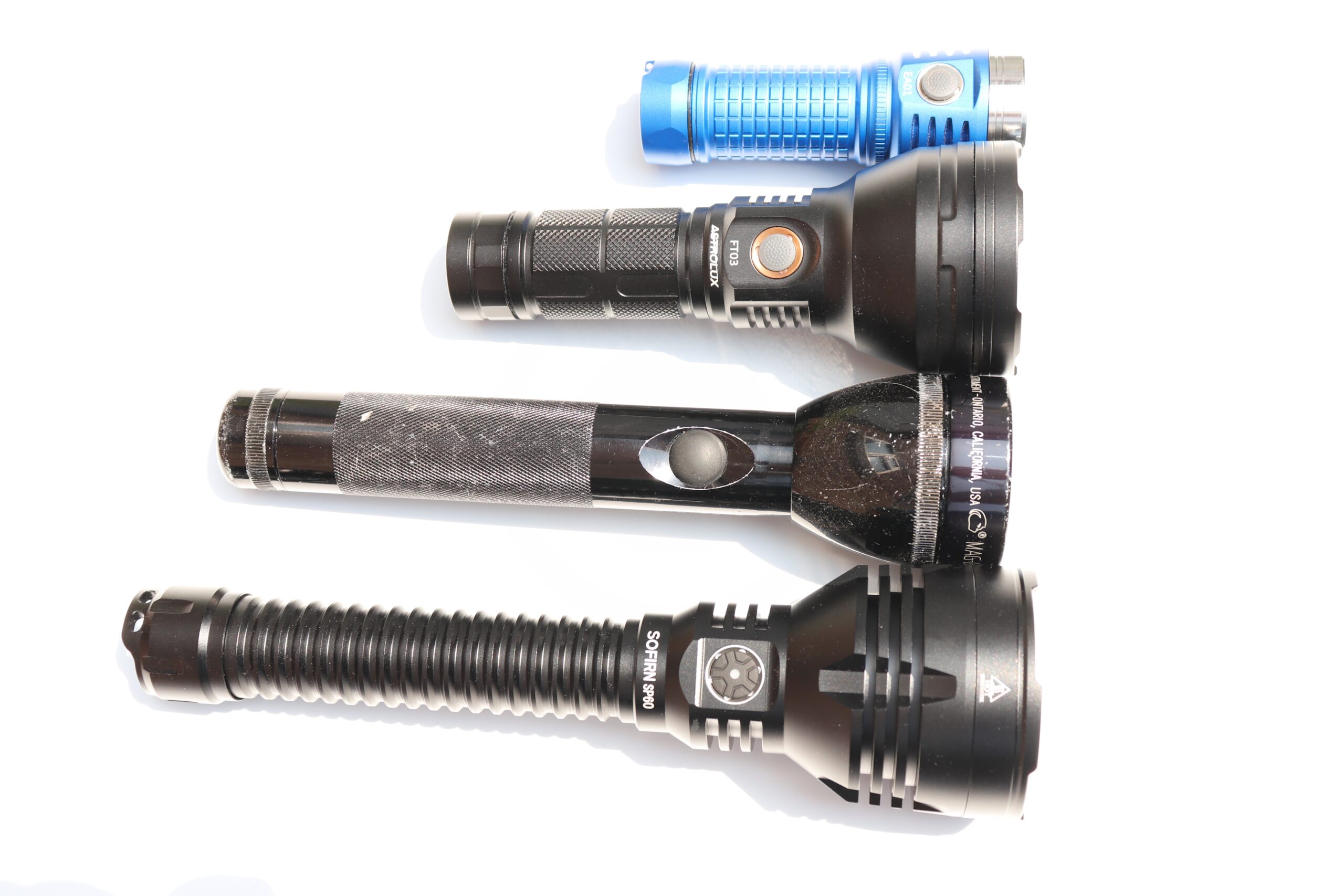
Sofirn SP60 UI: User Interface and Driver
Available modes:
- 6
Available blinky modes:
- Strobe, SOS, Beacon
From OFF:
- Press and hold: Moonlight
- Single click: On (last mode memory)
- Double click: Turbo
- 3 clicks: Strobe
All of the above are only when unlocked.
From ON:
- Press and hold: Scroll modes
- 1 click: Off
- Double click: Turbo
- 3 clicks: Strobe
Mode memory:
- Yes
Shortcuts:
- To Low: No
- To Turbo: Yes (2 clicks)
- To Strobe: Yes (3 clicks)
Low voltage warning:
- LED in switch
Strobe/blinkies
- Yes (3 clicks)
Lock-out mode:
- Automatic after 3 mins, cannot be configured or disabled. Can be manually activated.
PWM
- None that I could detect
Additional/summary info on the UI:
- The auto-locking feature is very annoying and prevents the moonlight or turbo shortcut working, unlocking the light automatically turns it on in the last used mode. So bad luck if you want a low output and last used High.
Sofirn SP60 Charging and batteries
The SP60 comes with 2 x Sofirn branded 5000mAh 21700 batteries. These batteries are ok, but in other applications, I have found they are more capacity focused than performance.
The batteries are of the flat top variety, which is common for 21700 cells. In order for these to work in Series, Sofirn provides a metal tube that you have to insert the batteries into. This tube is essentially a workaround for the lack of button top cells. as it contains a pin like platform in the middle. Meaning you need to insert a battery from each end and the batteries don’t physically touch, but make contact through this pin, in place of a button top.
In a way this is quite a clever workaround for the lack of 21700 button tops. And the tube looks like it should work with real button top cells too. However, it means the inside diameter of the SP60 is bigger to cater for this tube. So you will need to use the tube, even if you have button-top cells. It also makes it far easier to insert a cell the wrong way around, so extra care must be taken when inserting the batteries. It is also a little more fiddly, requiring two hands and tilting the body up and down, so as to not deposit one battery on the floor by mistake. The SP60 has a spring in the tailcap and on the driver board to support the use of flat tops batteries.
However, as the SP60 supports onboard charging, you in theory should not need to remove the batteries very often. Although I must confess, I do have reservations about serial charging of Li-ion cells, as there is no way for the charger to know the individual voltages of each cell. Maybe I’m being old fashioned, but unless in an emergency, I would still opt to remove the batteries and charge in a dedicated charger.
If you do use the onboard charging, it is as easy as plugging in the provided USB-C cable. The power switch flashes red while charging and turns solid green once charged. Charge times will vary depending on the power output of the USB-C socket you are using, but expect charge times to be in the region of 2-4 hrs+ with a max rate of about 2-3amps.



Performance test
Lumen measurements
How Lumens are Measured: Understanding ANSI FL1 Standards How Lumens are Measured: Understanding ANSI FL1 Standards: The ANSI FL1 standards specify that output in lumens should be measured 30 seconds after turning on, as this is the standardized time for measuring brightness according to the industry standard. This is why we focus on this part in our measurements. The ANSI FL1 standards require an ambient temperature of 22 ± 3°C. We record the ambient the ambient temperature to identify potential reasons for any observed discrepancies.While the real World performance of the SP60 is very good, it got nowhere near its claimed turbo output figures. In fact performance from High and Turbo modes are both disappointing from a numbers point of view vs claimed outputs. Once outside and using the light however it doesn’t actually disappoint. So I’m not sure if the claims are inaccurate or not.
I do know from past testing that the Sofirn 5000mAh batteries are not high performance ones, so maybe something punchier like a pair of Samsung 30T’s would have yielded better results, although it needs almost a 100% increase in output to meet the claimed figures. But I must stress that in actual use this is not an issue at all and I really wouldn’t want the SP60 getting any hotter than it currently does.
Run time stats are also interesting in that they don’t remotely tally up with the claimed figures either. And arguably it is disappointing that so many lights these days have no form of flat regulated output. I’d have thought 2 x Li-ion running a single emitter would be the ideal platform for nice flat regulation on some modes. But all seem to have gradual curves to the output plot.
| Mode | Amps at start | Specs | at turn on | 30 sec | 10 minutes |
|---|---|---|---|---|---|
| Moon | <0.01 | 1 | 1 lm | 1 lm | 1 lm |
| Eco | 0.10 | 50 | 37 lm | 37 lm | 37 lm |
| Low | 0.68 | 450 | 232 lm | 232 lm | 226 lm |
| Med | 1.42 | 1000 | 518 lm | 517 lm | 501 lm |
| High | 3.14 | 3000 | 1278 lm | 1270 lm | 711 lm |
| Turbo | 9.24 | 6800 | 3668 lm | 3318 lm | 762 lm |
Sofirn SP60 Battery Life: Runtime graphs
How Runtimes are Measured: Understanding ANSI FL1 Standards About ANSI FL1 runtime standards: The runtime is measured until the light drops to 10% of its initial output (30 seconds after turning on). This does not mean that the flashlight is not usable anymore. The last column shows how long the light actually works till it shuts off. If there is a + symbol, it means that the test was stopped at that particular point, but the light was actually still running. This happens on certain occasions, with certain drivers, firmware, or batteries.| Mode | Specified | Measured runtime ANSI | Time till shut off |
|---|---|---|---|
| Moon | 480h | – | – |
| Eco | 60h | – | – |
| Low | 9h | 11h 19min | 12h 56min |
| Med | 3.5h | 4h 59min | 6h 44min |
| High | 2h | 3h 18min | 5h 17min |
| Turbo | 1.5h | 2h 55min | 5h 04min |
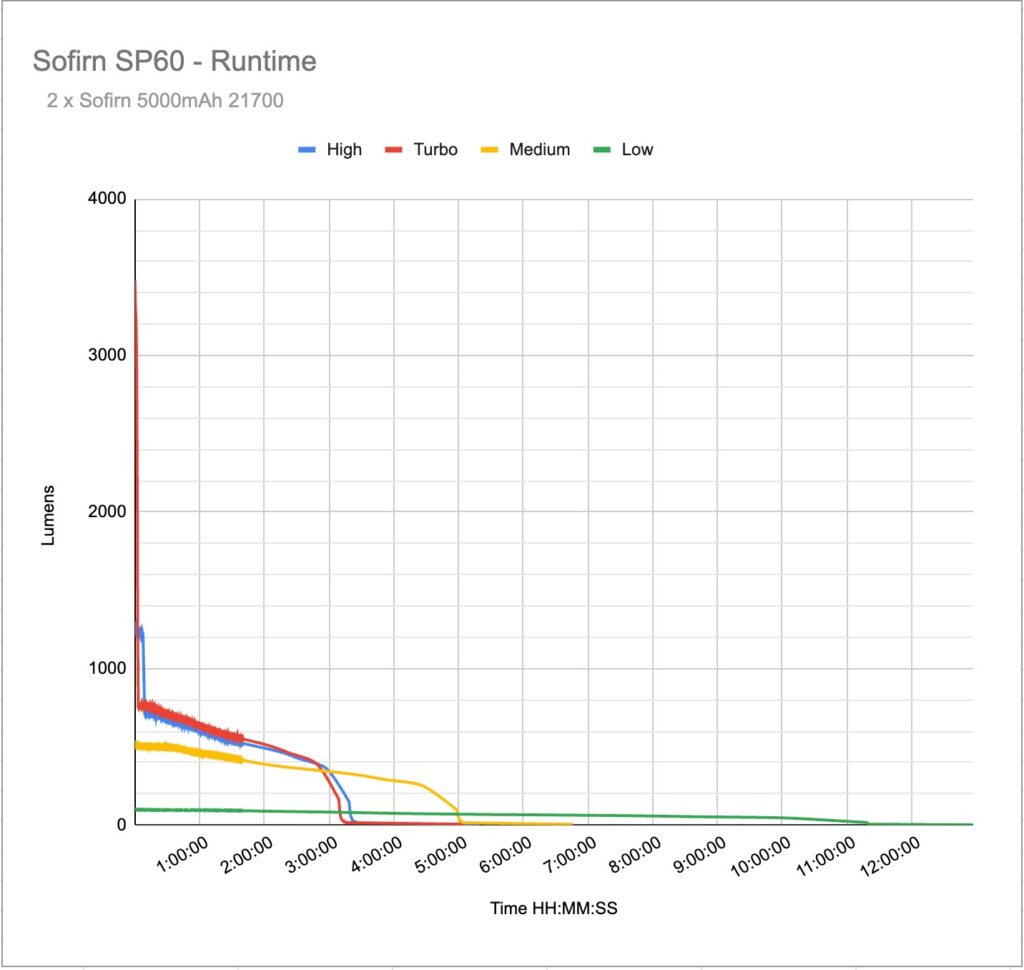
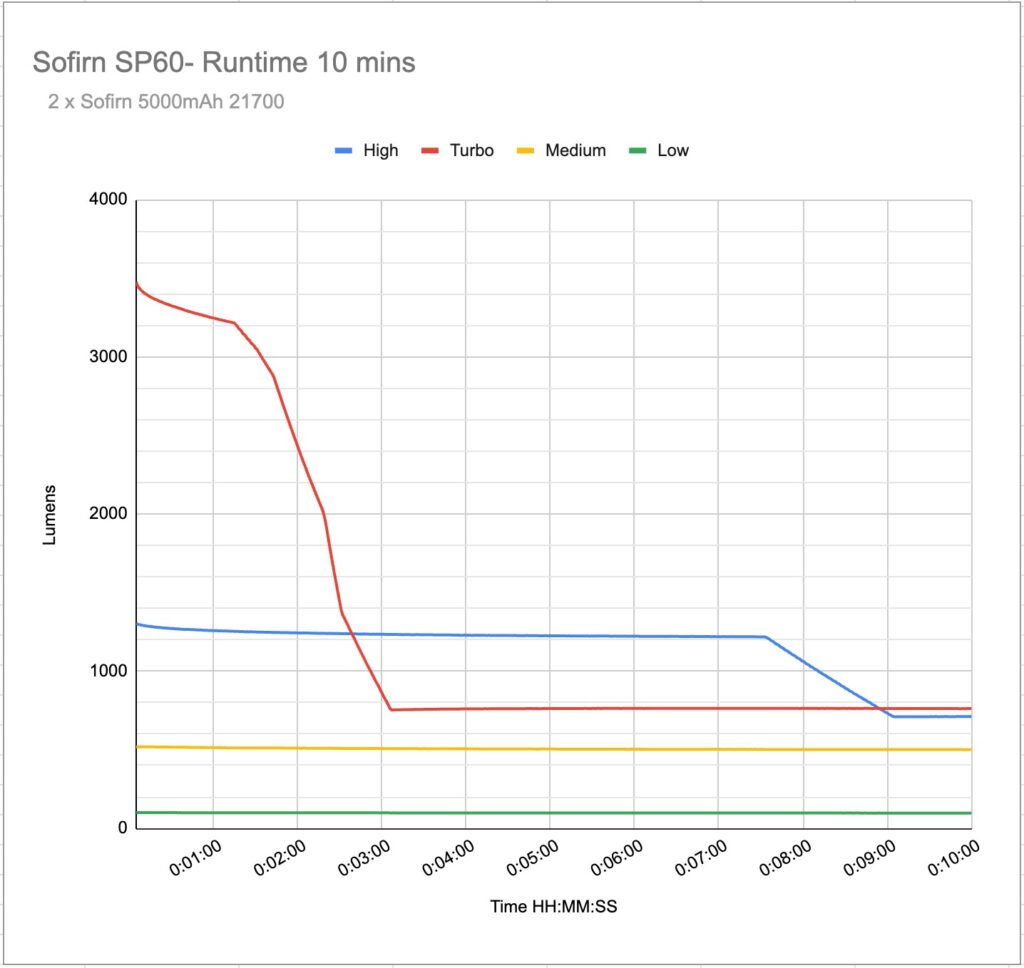
Peak beam intensity and beam distance measurements
About Peak beam intensity: Understanding ANSI FL1 Standards About peak beam intensity The calculated value of distance in meters at which the flashlight produces a light intensity of 0.25 lux. (0.25 lux is about the brightness of a full moon shining on an object). This means that the intensity has decreased so much, it becomes difficult to see darker objects, or objects that don’t reflect light. The columns ‘Meters’ and ‘Yards’ use rounded numbers.| Mode | Specs | Candela measured | Meters | Yards |
|---|---|---|---|---|
| Moonlight | 80cd / 18m | 74 | 17 | 19 |
| Eco | 2075cd / 91m | 2240 | 95 | 104 |
| Low | 13000cd / 228m | 13566 | 233 | 255 |
| Medium | 35000cd / 374m | 31012 | 352 | 385 |
| High | 99500cd / 631m | 74816 | 547 | 598 |
| Turbo | 209500cd / 915m | 160388 cd | 801 | 876 |
Beamshots
Camera settings and distance: Canon EOS 200D – Canon 18-55mm EFS IS – 2”/F6.3/ISO 400/WB 5200k “Daylight”
100m
Beamshots of the following flashlights compared:
- Amutorch XT45
- Astrolux EA01 SST-40
- Astrolux FT03 XHP50.2
- Sofirn IF23 XHP50B
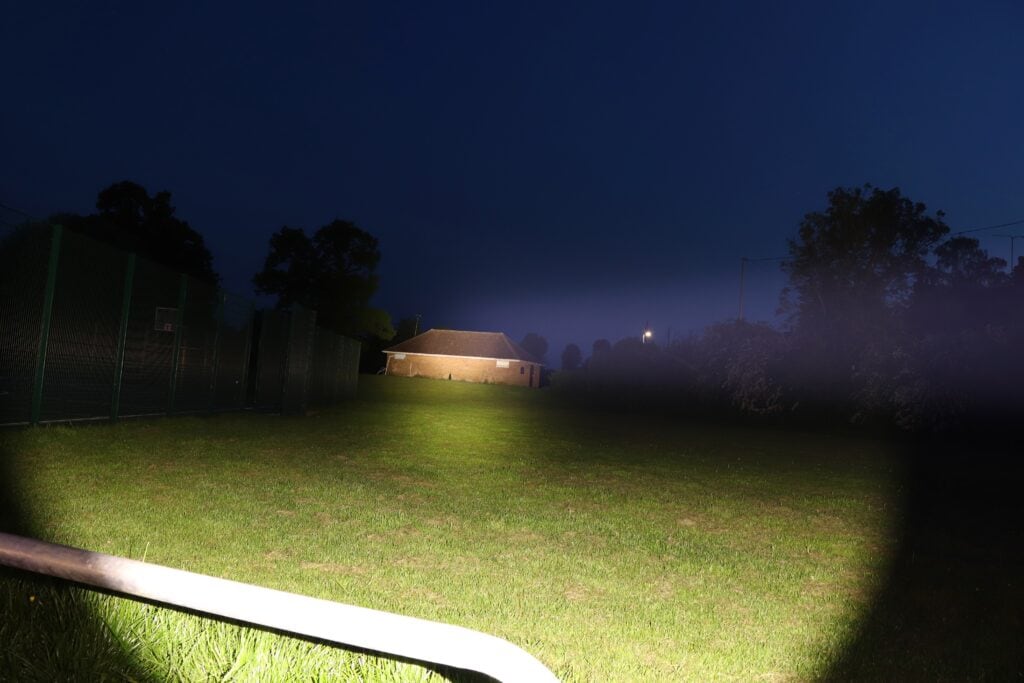
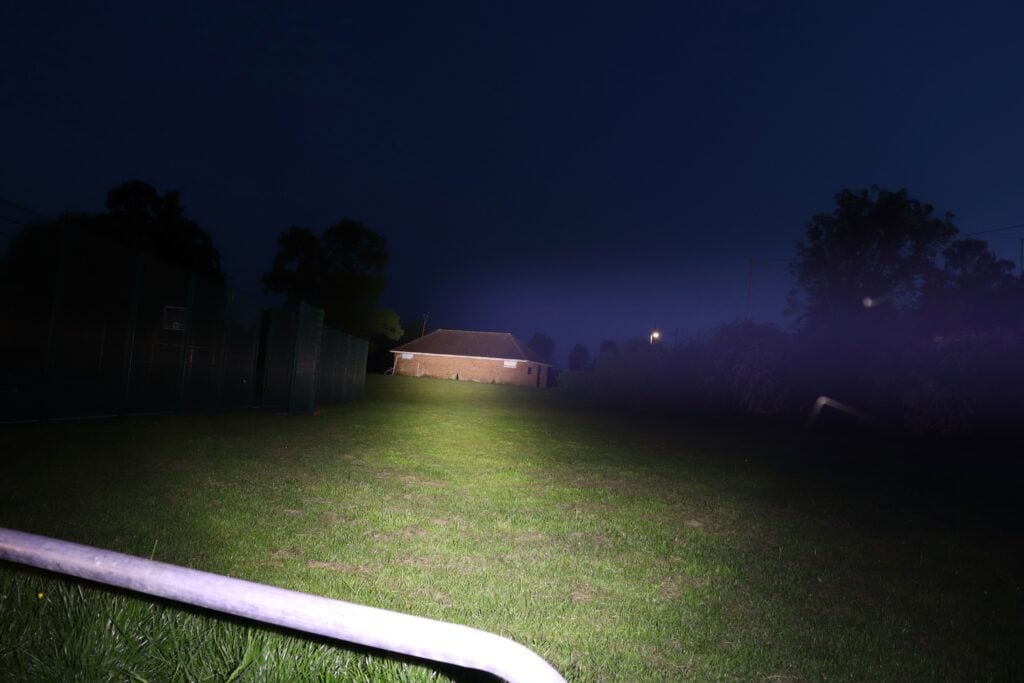
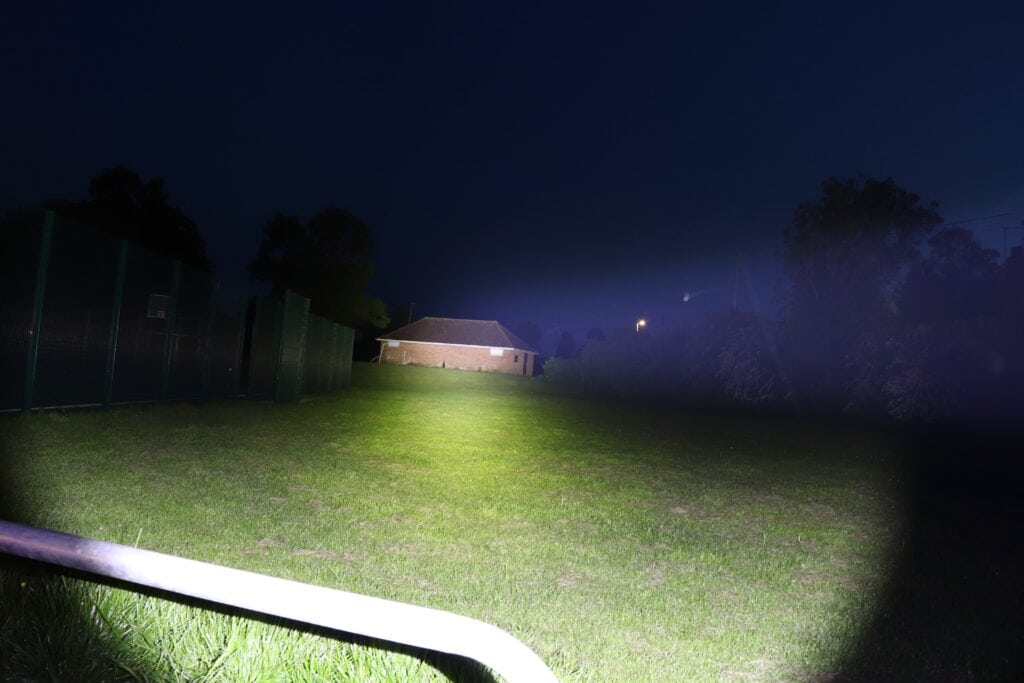
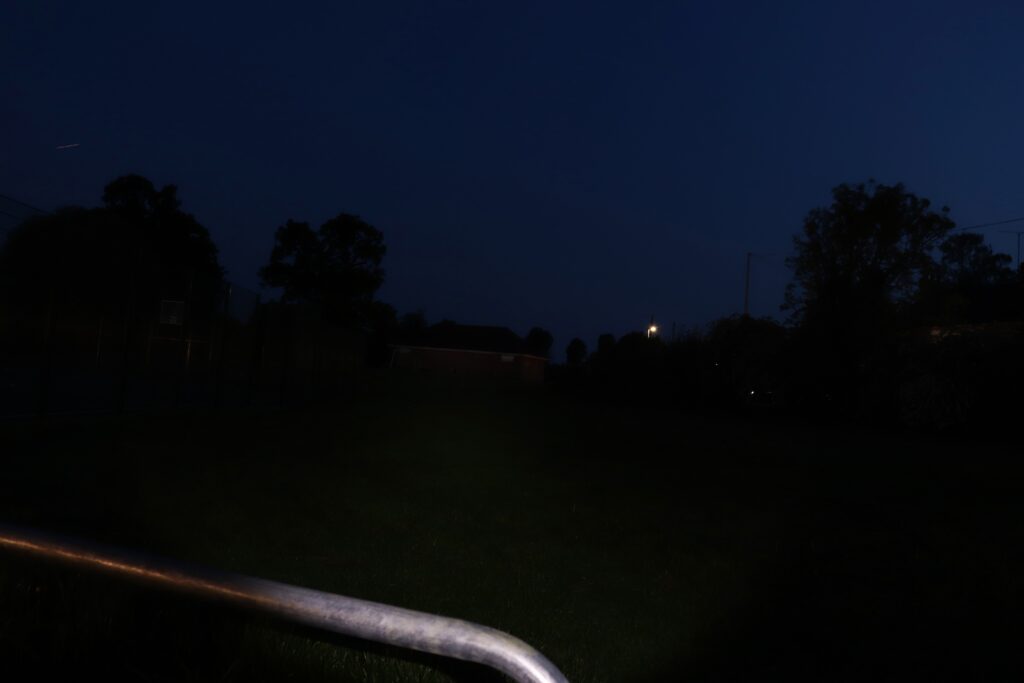

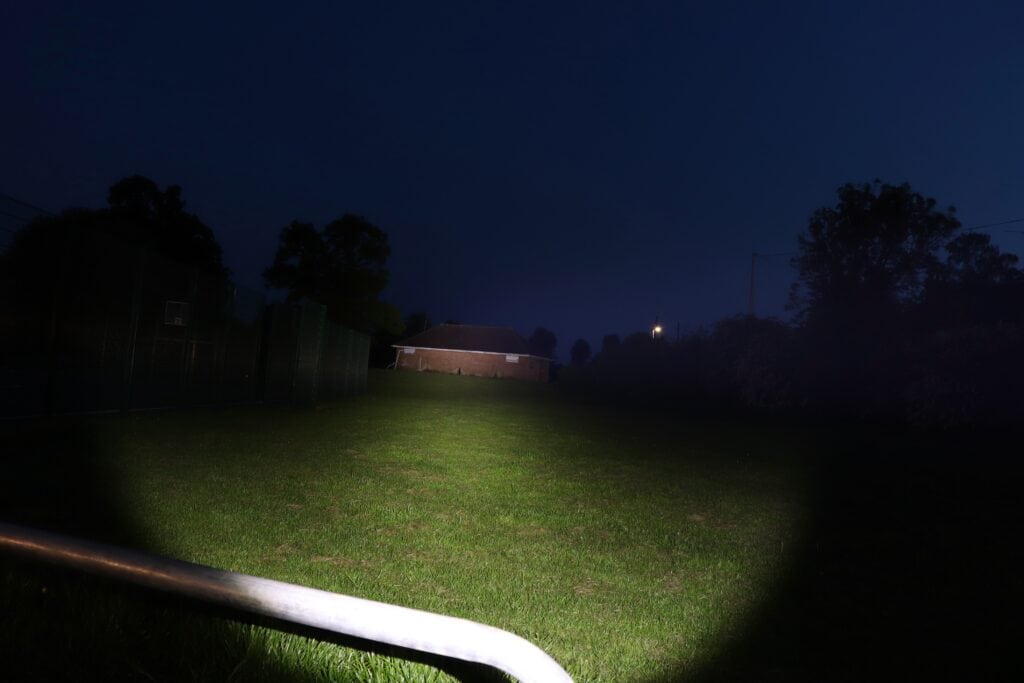
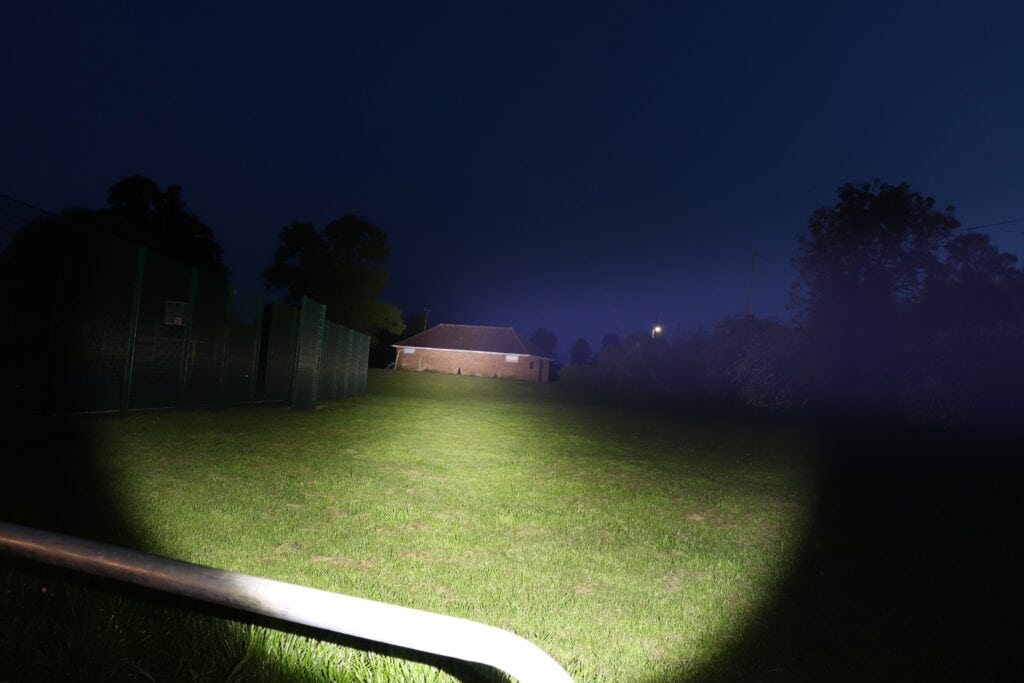
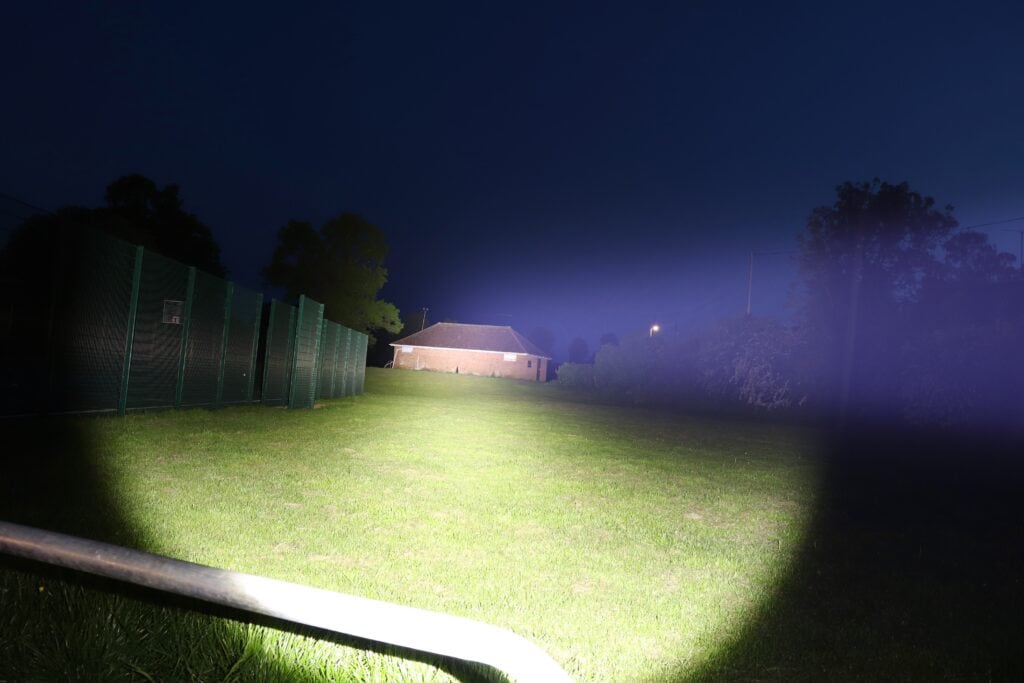
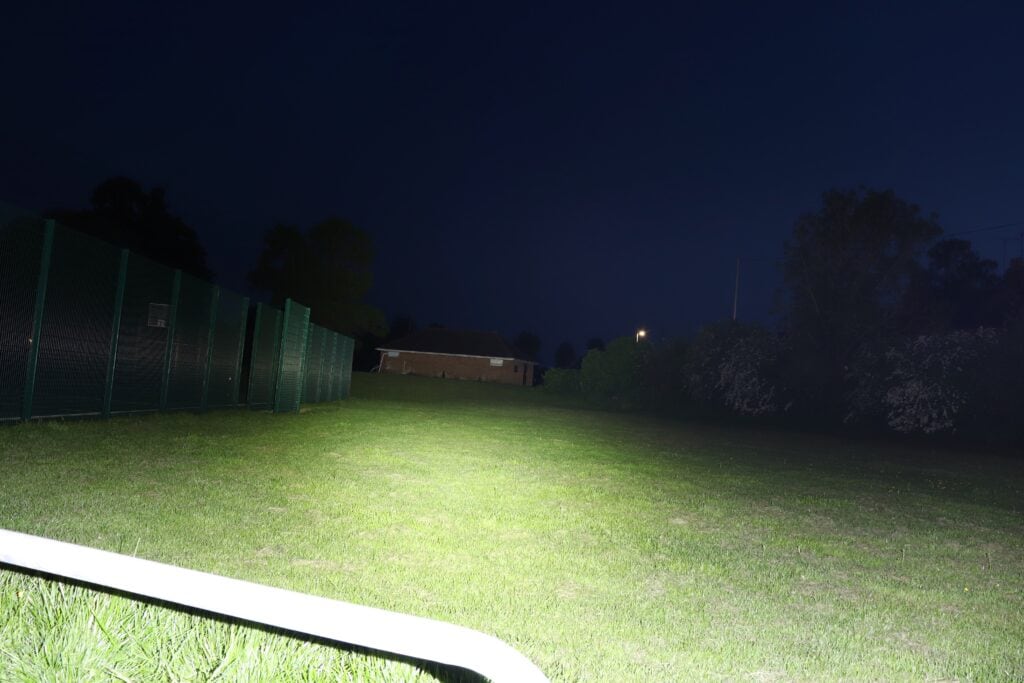
Disclaimer: This flashlight was sent to me for review at no cost by Sofirn. I have not been paid to review, nor have I been holding back on problems or defects.
Final Verdict
Pros
- Beam
- Performance
- Big & heavy
Cons
- Autolock
- No physical lockout
- Big & heavy
Explanation on star ratings:
1: Avoid: a match would be a better choice – 2: Poor: significant defect or issues; almost unusable – 3: Average: some defects or issues; but still usable 4: Good: recommended (minor issues) – 5: Great: highly recommended

3.5 stars: ★★★⋆
While our star rating provides a reliable indicator, we encourage you to read the full review to make an informed decision based on your own needs and preferences.
There is much to like with the SP60, the performance, modes and beam are all great. But there is no denying it is a big heavy torch. Which in 2023 feels a little outdated compared to the pocket sized offerings that punch very high. That said, many people will like the tactile feel of a larger heavier flashlight.
The points that really hold the light back for me are the auto locking feature. It sounds great in theory, but it is highly annoying. And stops things like the moonlight mode being as usable as it should be. There is also no physical lockout with the bare tailcap threads. Which means batteries will drain, and despite the electronic lockout, there is always risk of it activating in a bag. I also find it irritating that when you are in Turbo mode and go to turn the light off that it reverts to another output, forcing you to faff about with the switch for no real purpose.
Buy your Sofirn SP60 with a discount
1lumen selects and reviews products personally. We may earn affiliate commissions through our links, which help support our testing.